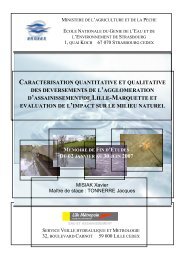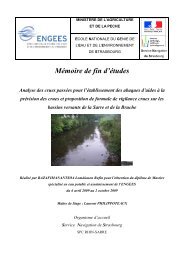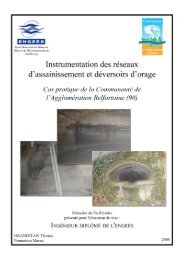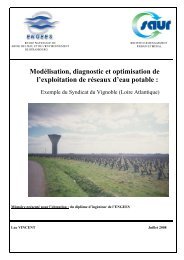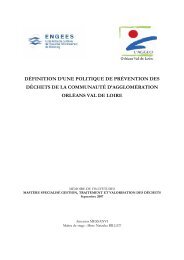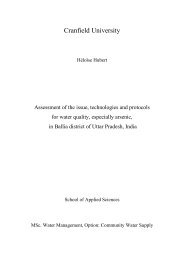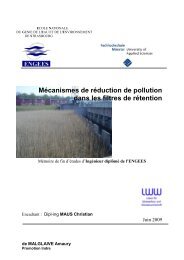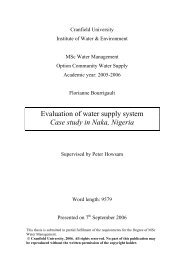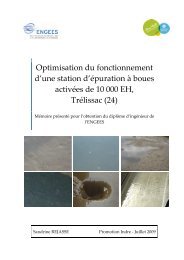PDF (Rapport) - ENGEES
PDF (Rapport) - ENGEES
PDF (Rapport) - ENGEES
Create successful ePaper yourself
Turn your PDF publications into a flip-book with our unique Google optimized e-Paper software.
Ville de Fontaine-lès-Dijon<strong>Rapport</strong> de stage de fin d’étudeModélisation et diagnostic hydraulique du réseau d’eau potable de la Ville de Fontaine-lès-DijonModelisation and hydraulic diagnostic of drinkingwater supply network from Fontaine-lès-DijonABSTRACTThe town of Fontaine-les-Dijon currently houses more than 9,200 residents. Havingseen some major development and urbanisation for the last 20 years, it’s necessaryfor this border district of the urban area of Dijon to assess its drinking water supply.(AEP)Fontaine-les-Dijon is part and parcel of the community of districts of Grand Dijon.Its management has been delegated to the Combined Association of Dijon Residents(SMD). In this central organization, Fontaine-les-Dijon, does not have its ownresources. It is fed by Dijon’s bulk purchase like the majority of the other 23 districtsof Grand Dijon.The main issue of the AEP model of the Fontaine-les-Dijon system is to define aconvenient working diagnosis on average and peak days. Initially, the objective wasto evaluate and target the problems which are likely to damage the properfunctioning of the district’s water supply. Subsequently, the second objective was toestablish an assessment of the district’s fire protection. The establishment of a modelhas enabled us to analyse the real way the drinking water network functions and toidentify its inadequacies.In order to reveal the failings of the drinking water network, we have made a modelof the network, thanks to the Piccolo software program. The model was checked bymatching the results obtained with the measurements made on the field.The Piccolo simulation of the current situation shows both the local supply areas thatare subjected to heavy pressure (more than 6.5 bars) and the insufficient pressure(less than 1.5 bars). The diagnosis allows to show high residence time of the water insome areas. In the context of the fire protection, the model revealed 38 fire hydrantsthat are not in compliance with the recommended regulations.Specific and timely responses have been identified to correct these inadequacies;those include reinforcing pipes, installing pressure valve control and also addingextra piping.Hugues QUEGUINERSAFEGEAgence Bourgogne Franche-Comté




